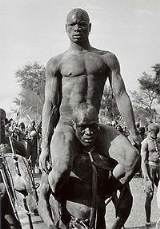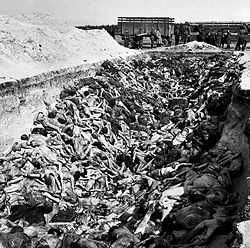
George Rodger
Encyclopedia

Great Britain
Great Britain or Britain is an island situated to the northwest of Continental Europe. It is the ninth largest island in the world, and the largest European island, as well as the largest of the British Isles...
photojournalist
Photojournalism
Photojournalism is a particular form of journalism that creates images in order to tell a news story. It is now usually understood to refer only to still images, but in some cases the term also refers to video used in broadcast journalism...
noted for his work in Africa
Africa
Africa is the world's second largest and second most populous continent, after Asia. At about 30.2 million km² including adjacent islands, it covers 6% of the Earth's total surface area and 20.4% of the total land area...
and for taking the first photographs of the death camps at Bergen-Belsen
Bergen-Belsen concentration camp
Bergen-Belsen was a Nazi concentration camp in Lower Saxony in northwestern Germany, southwest of the town of Bergen near Celle...
at the end of the Second World War.
Born in Hale, Cheshire
Hale, Greater Manchester
Hale is a village and electoral ward within the Metropolitan Borough of Trafford, in Greater Manchester, England. It is contiguous with the southeast of Altrincham, approximately southwest of the city of Manchester....
, of Scottish
Scotland
Scotland is a country that is part of the United Kingdom. Occupying the northern third of the island of Great Britain, it shares a border with England to the south and is bounded by the North Sea to the east, the Atlantic Ocean to the north and west, and the North Channel and Irish Sea to the...
descent, Rodger went to school at St.Bees School in Cumberland
Cumberland
Cumberland is a historic county of North West England, on the border with Scotland, from the 12th century until 1974. It formed an administrative county from 1889 to 1974 and now forms part of Cumbria....
then joined the British Merchant Navy and sailed around the world. While sailing, Rodger wrote accounts of his travels and taught himself photography to illustrate his travelogues. However, he was unable to get his travel writing published; after a short spell in America, where he failed to find work during the Depression
Great Depression
The Great Depression was a severe worldwide economic depression in the decade preceding World War II. The timing of the Great Depression varied across nations, but in most countries it started in about 1929 and lasted until the late 1930s or early 1940s...
, he returned to Britain in 1936. In London he was fortunate to find work as a photographer for the BBC
BBC
The British Broadcasting Corporation is a British public service broadcaster. Its headquarters is at Broadcasting House in the City of Westminster, London. It is the largest broadcaster in the world, with about 23,000 staff...
's The Listener magazine, which was followed in 1938 by a brief stint working for the Black Star
Black Star
-In astronomy:*Dark star , a theoretical star that has a surface escape velocity that equals or exceeds the speed of light*Dark star , a theoretical star heated by dark matter annihilation in the early universe...
Agency.
With the outbreak of the Second World War, Rodger had a strong urge to chronicle the war. His photographs of the Blitz
The Blitz
The Blitz was the sustained strategic bombing of Britain by Nazi Germany between 7 September 1940 and 10 May 1941, during the Second World War. The city of London was bombed by the Luftwaffe for 76 consecutive nights and many towns and cities across the country followed...
gained him a job as a war correspondent for Life
Life (magazine)
Life generally refers to three American magazines:*A humor and general interest magazine published from 1883 to 1936. Time founder Henry Luce bought the magazine in 1936 solely so that he could acquire the rights to its name....
magazine. He covered the war in West Africa extensively and towards the end of the war followed the allied liberation of France
France
The French Republic , The French Republic , The French Republic , (commonly known as France , is a unitary semi-presidential republic in Western Europe with several overseas territories and islands located on other continents and in the Indian, Pacific, and Atlantic oceans. Metropolitan France...
, Belgium
Belgium
Belgium , officially the Kingdom of Belgium, is a federal state in Western Europe. It is a founding member of the European Union and hosts the EU's headquarters, and those of several other major international organisations such as NATO.Belgium is also a member of, or affiliated to, many...
and Holland
Netherlands
The Netherlands is a constituent country of the Kingdom of the Netherlands, located mainly in North-West Europe and with several islands in the Caribbean. Mainland Netherlands borders the North Sea to the north and west, Belgium to the south, and Germany to the east, and shares maritime borders...
. He also covered the retreat of the British forces in Burma and was probably the only British war reporter/photographer to be allowed to drive along and write a story on the Burma Road
Burma Road
The Burma Road is a road linking Burma with the southwest of China. Its terminals are Kunming, Yunnan, and Lashio, Burma. When it was built, Burma was a British colony.The road is long and runs through rough mountain country...
by travelling on it into China
China
Chinese civilization may refer to:* China for more general discussion of the country.* Chinese culture* Greater China, the transnational community of ethnic Chinese.* History of China* Sinosphere, the area historically affected by Chinese culture...
, with special permission from the Chinese commanding generals.
Most notably, Rodger was the first photographer to enter the concentration camp at Bergen-Belsen
Bergen-Belsen concentration camp
Bergen-Belsen was a Nazi concentration camp in Lower Saxony in northwestern Germany, southwest of the town of Bergen near Celle...
in 1945. His photographs of the few survivors and piles of corpses were published in Life and Time
Time (magazine)
Time is an American news magazine. A European edition is published from London. Time Europe covers the Middle East, Africa and, since 2003, Latin America. An Asian edition is based in Hong Kong...
magazines and were highly influential in showing the reality of the death camps. Rodger later recalled how, after spending several hours at the camp, he was appalled to realise that he had spent most of the time looking for graphically pleasing compositions of the piles of bodies lying among the trees and buildings.

In 1947, Rodger became a founder member of Magnum Photos
Magnum Photos
Magnum Photos is an international photographic cooperative owned by its photographer-members, with offices located in New York, Paris, London and Tokyo...
and over the next thirty years worked as a freelance photographer, taking on many expeditions and assignments to photograph the people, landscape and nature of Africa. Much of Rodger's photojournalism in Africa was published in National Geographic as well as other magazines and newspapers.
Publications
- Red Moon Rising, The Cresset Press 1943
- Desert Journey, The Cresset Press, 1944
- Village des Noubas (1955)
- Le Sahara (1957)
- George Rodger : Humanity and Inhumanity (1994)
External links
Sample portfolio of Rodger's WWII photographs- Brunei Gallery, sample of Rodger's African photographs
- The Nuba Mountains Homepage
- Contact: George Rodger's War Photographs Imperial War Museum North | 9 February - 27 April 2008 | Free entry

